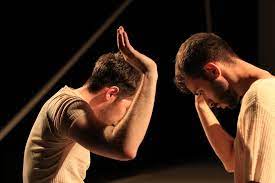Choreographer and ardent collaborator Britta Joy Peterson has been creating dance, video, and performance pieces in the Washington, DC, region since 2016, when she took a position a professorial lecturer at American University in the District.
Her newest piece, And Now, Hold Me, is part of a trilogy that she began work on in 2014 or ’15, she said after Saturday evening’s program at Dance Place. Each work — including “Vinegar Spirit,” which came to Dance Place in January 2019 — wrestles with time and space in intentional ways to tease out philosophical and phenomenological concepts in a kinetic palette. What’s most interesting about this triptych of pieces is Peterson’s keen focus on space and how the introduction of bodies moving through it changes, literally, everything — the architecture, the meaning, the temperature, the feeling, even the air in the room reshapes itself. For And Now, Hold Me, a duet, the space designed by Elsa Rinde creates a stage within a stage demarcated by white PVC pipes slanted like a giant soccer goal framing the performers, with a white floor all floating in the larger surrounding black void.

Two men, sharply dressed in wool coats, neat sweaters, slacks, and shoes, sit cross-legged on the floor looking like schoolboys awaiting roll call. “In the beginning … and now,” one intones. Then a monologue spoken in succession by both men, but not to one another, pours forth, in poetically Biblical cadences about flesh and how it’s in and of the world, the stuff of life, it provides a way of perceiving and making meaning. “Through flesh,” one says, “I know you.” Still seated, they twist, bend, windshield-wiper their knees, gesture in perfectly intricate unison and a low thrum of sound crescendos. Like twin brothers they rise and begin to disrobe. A shift in Evan Anderson’s lights transforms the backdrop, which appeared as colorful and white vertical blinds, into a loosely woven web of multicolored ribbon, which streams from a giant spool at the side of the stage. Dancer Dylan Lambert behind stage pulls ribbon from the endless spool and adds to the spidery tapestry.
Meanwhile, with slippery grace, Sergio Guerra Abril meanders between gestural brushes of his hair and loosely articulate twists, tumbles, balances that unwind and rewind, a manifestation of the unspooling ribbon. What becomes a series of episodes, silent playlets in a sense, is broken up by canned applause, when each performer pauses for an unironic bow. Guerra Abril dons a shimmery blouse, red go-go books, and a flouncy white skirt for a playful lipsync of “Desatame” by Monica Naranjo. His playful drag and voguing offers up a fantastic death drop, a split-second fall to the back, one leg sexily raised in the air.
Lambert then has his own bit of fun impersonation. Introduced by a few bars from Van Halen’s “Jump,” he enters with towel and yoga mat, converses with imagined gym rats about exercise, bitcoin, and dogecoin, all in perfect yoga-bro fashion.
An improvisational duet on expected feminine and masculine tropes allows the dancers to tweak social and cultural expectations of the alpha male and bitchy female. Guerra Abril reads from a series of shlocky blog posts that advise that men should “take up more space to look more powerful” while women should “avoid pain at all costs.” All the while they tumble, lift, balance one another on a hip or shoulder in an easygoing improvisation. On either side, sign language interpreters make this and all the spoken word accessible.
As the work winds down, strains of Liszt’s dreamy “Liebestraum No. 3” build, shifting the demeanor of the space that has contained so many moments of bodies moving and filling the void, light painting over the darkness, architecture delineating the blank stage canvas. The two men begin packing up the clothing and props; the woven spidery tapestry, their own words and phrases, parsed out over the course of nearly an hour have reached a quiet moment of intimacy. “And, now … the end” arrives, but, still, they’re not finished. There’s one more thing to do.

They stand and, finally, hug, body to body, flesh to flesh. Two become one. Space and time have contracted and exploded. While And Now, Hold Me is absolutely not a “pandemic piece,” this moment of coming together resonated in a world where many people have not hugged or been hugged for nearly two years now as the ongoing challenges of isolation and quarantine continue to hold some hostage to COVID-19 and its variants. Peterson’s work meditates on time and space, with moments of moving beauty, irony, fun, and, finally, a thoughtful confluence of bodies and flesh. I’ve avoided writing on her work until now because I hadn’t found enough in it that appealed to me. In And Now, Hold Me, I discovered much that spoke to me, particularly through the exquisite performances of Abril and Lambert, as well as the finely conceived structure and expert production of Peterson’s artistic and advisory team. I’m glad I returned to her work to discover a deeply conceptual study of what it means to move and take up space. A solo dancer on stage evokes an individual’s world, but Peterson shows us that two people sharing space create a universe of possibilities.
Running Time: Approximately 55 minutes.
And Now, Hold Me — directed and choreographed by Britta Joy Peterson, with performance and movement collaboration by Sergio Guerra Abril and Dylan Lambert — played January 22–23, 2022, at Dance Place, 3225 8th St. NE, Washington, DC.
“And Now, Hold Me” teaser from britta joy peterson on Vimeo.
COVID Safety: Dance Place’s complete COVID-19 policies and protocols are here.




